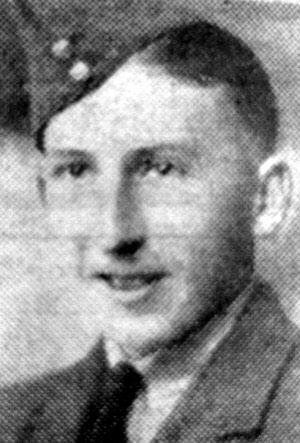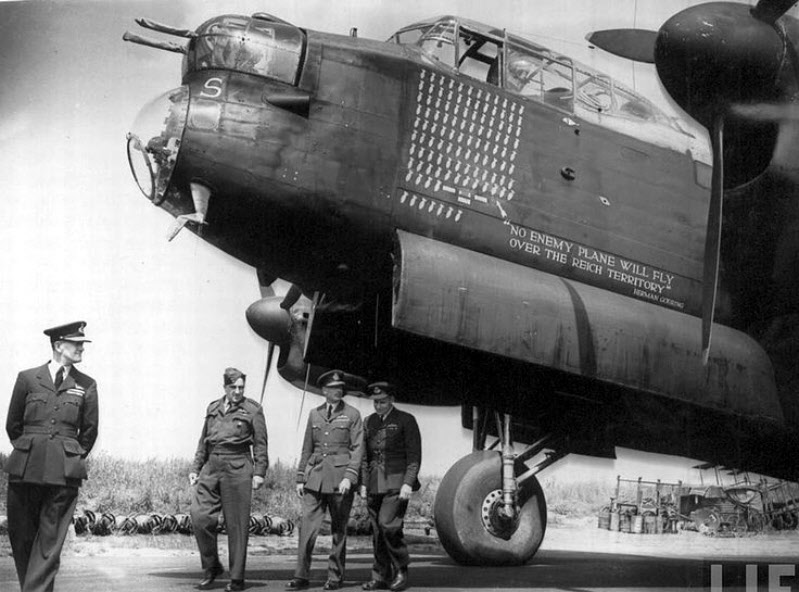
John Watts Bagley was born in summer 1920, the eldest son of Manchester born Harold and Leeds born Amy Bagley (nee Watts) of Horbury, who married at Morley Parish Church on the 22nd January 1908. Harold was an overlooker living at Station Road, Ossett and Amy was a dressmaker living at Bank Street, Morley. Harold’s father, John Bagley, was the station master at Ossett Railway Station. In 1911, Harold and Amy were living at 17, George Street, Ossett with their daughter, Edith Amy, aged 2 years.
In late 1932, Edith Amy Bagley was to marry Leonard Wilby Cussons, the grandson of Thomas Tomlinson Cussons. Thomas established and was Chairman of the British soap manufacturing company Cussons & Son. In the early 1880s Thomas opened a chemist in Station Road, Ossett.
John Watts Bagley married Nancy Mews of Horbury just ten weeks before his death in the winter of 1943. John Watts Bagley of ‘Wyndene’, Horbury died on the 20th April 1943 on war service. Administration was granted to his widow Nancy. Effects £367 5s 5d.
Sergeant J.W. Bagley was the wireless operator and air gunner on a 57 Squadron Lancaster bomber based at RAF Scampton in Lincolnshire. 57 Squadron had moved to RAF Scampton in September 1942 and converted to Avro Lancaster bombers after previously flying Wellington bombers. The squadron moved again in August 1943 to East Kirby.
He took part in the raid on the Baltic port of Stettin on the 20/21st April 1943, which involved 339 aircraft (194 Lancaster, 134 Halifax and 11 Stirling bombers), of which 31 were lost during the operation. The Pathfinder marking was accurate, resulting in the destruction of some 100 acres of closely grouped industrial buildings and the death of 586 people.
13 Lancaster, 8 Halifax and 9 Stirling bombers were lost and about twenty of these aeroplanes were lost over Denmark or in Danish waters. About 20 of the 31 planes were lost due to flak, whilst 66 planes were damaged by mainly 20mm light flak and 80% of the planes had flown lower than 500ft when they were hit.
About 30 engagements and attacks by German night fighters were reported. ME109 and ME110s had been active over the target area. JU88s had been active over Denmark when the formation was outbound and during the return flight. Two JU88s were reported shot down by Lancasters from 5 Battle Group at Odense and Vejle.
It was on the return journey from Stettin when flying over Denmark that Bagley’s Lancaster was hit by flak. The aeroplane was badly damaged and Sergeant John W. Bagley was killed instantly together with 19 year-old Flight Engineer Peter Bigg from Ruislip in Middlesex. The pilot of Bagley’s Lancaster managed to get the crippled bomber over the North Sea and landed safely back in England, but it was already too late for John Watts Bagley and Peter Bigg; they were both already dead.
The “Ossett Observer” had this obituary for Sergeant John Watts Bagley:1
“Horbury Airman’s Death – Caught By German Flak – Last week we announced the sad news received by Mrs. Nancy Bagley, Kirkgate, Wakefield that her husband, Sergeant John Watts Bagley (22), R.A.F.V.R., had been killed whilst on active service. He was the eldest son of Mr. and Mrs. Harold Bagley, ‘Wyndene’, Horbury and was educated at Ossett Grammar and Pocklington Schools, afterwards entering his father’s business of mungo manufacturer in Ossett. A keen sportsman, he played for Ossett Rugby Club for several seasons. He joined the RAF as a volunteer in July 1940, and has taken part in many operational flights over Germany, Italy and occupied countries as bomb aimer. He was on a raid to Italy only two days before his death. He was married ten weeks ago.
Further particulars have just come to light with regard to Sergeant Bagley’s death. His Wing Commander, writing to the widow says the aircraft in which he was flying as bomb aimer had completed a sortie against the German port of Stettin, and was returning to base, but when crossing the Danish coast, the aircraft was hotly engaged by ground defences and suffered considerable damage. The pilot did everything in his power to save the crew, but, unfortunately, Sergeant Bagley and the Flight Engineer were killed instantly. Despite the severe damage, the pilot landed his aircraft in this country, but unfortunately, the immediate medical attention given was to no avail. Sergeant Bagley was a bomb-aimer of exceptional quality, and it was tragic he should lose his life at the commencement of what promised to be a successful tour of operations. The letter expressed the profound sympathy which he, personally, and all the members of the squadron felt with the family for their sad loss. A letter from the Squadron Leader offered, as Sergeant Bagley’s captain and pilot, his sincere sympathy, and added ‘Although it is a poor consolation, I am sure you would like to know that your husband was killed in action, sticking to his guns after we had pressed home a most successful attack on an enemy target.’
It is worthy of note that Sergeant Bagley comes from rare fighting stock, there having been a Sergeant Bagley in the family for over a century. His great-great-grandfather had a leg shot off on HMS Victory at the Battle of Trafalgar, and his great-grandfather, Sgt. John Bagley, 60th Royal Rifles, served through the Indian Mutiny and Zulu War. Mr. John Bagley, J.P., of Marsden who is 89, was in the Militia and is one of the very few people living today who was under fire during the Indian Mutiny. An uncle, Quartermaster-Sergeant Reginald Bagley K.O.Y.L.I. served all through the last war. Sergeant J.W. Bagley’s father (Mr. Harold Bagley) served in Palestine. It is a strange coincidence that Private Jim Bagley, another of his father’s brothers was killed in action twenty-five years ago to the day of receiving the sad news in this case.
The funeral took place at Horbury Cemetery on Saturday afternoon, preceded by a service at St. Peter’s Church, Horbury conducted by the vicar (the Rev. R. Combe). The choir was in attendance and the hymns “Abide with me” and “Never my God to Thee,” were sung, the vicar giving a short address. The mourners were Mrs. N. Bagley, Wakefield (widow); Mr. and Mrs. H. Bagley and Billy (father, mother and brother); Mr. and Mrs. L.W. Cussons (brother-in-law and sister); Mr. and Mrs. A. Bagley (Marsden), Private and Mrs. F. Bagley (Huddersfield) (uncles and aunts); Miss W. Bagley (Huddersfield) (aunt); Mr. H. Turner (Kent), Mr. W. Sowden (Heckmondwike), Misses E. and E. Sowden (Heckmondwike) (cousins); Mr. and Mrs. H. Mews (Wakefield) (father-in-law and mother-in-law); and Flight-Sergeant E. Bagshaw. There were also present employees from the firm of Harold Bagley, Ossett and representatives from Messrs. E. Green and Sons, Wakefield, Ossett Rugby Union Club and numerous friends.”

Above: A 57 Squadron Lancaster bomber R5868 “S-Sugar” up close.
Here is an eye witness account2 of the raid on the Baltic port of Stettin in Germany (now Poland) by 57 Squadron on the 20/21st April 1943 that cost John Bagley his life. Stettin, with a population of 380,000 by 1940, had become the third-largest German city by area, after Berlin and Hamburg:
“On the 5th March 1943 we were posted as a crew to No 57 Squadron, Scampton. We were taken by road. RAF Scampton was a very old station that had opened in 1916, and like most peace time stations had a grass airfield. When the war started there were only a few airfields with paved runways. At Scampton, we had a pleasant reception and we were introduced by the C Flight Commander, S/Ldr Curry, DFC. We were also shown around by S/Ldr Avis DFC. We were then shown to our living accommodation which was a house in what used to be the peace time married quarters. Almost all NCO aircrew were in houses which were within the camp, but away from the main buildings. We had a house to ourselves. It was two bedroom with bathroom, living room and kitchen.
Our next operation to Stettin was in bright moonlight and we flew at low level across the North Sea and Denmark. Before approaching the target we climbed to 12,000 feet but going into the target we were coned by searchlights. Jack dived the aircraft at about 380mph and we were down to 5000 feet before getting out. However we bombed and then got the hell out of it. After leaving Stettin we again flew at low level for most of the way back. There were 31 aircraft missing from this operation and 52 damaged by flak: duration 8 hours.”
Sergeant J.W. Bagley died on the 21st April 1943 aged 22 years and is buried at Horbury Cemetery, Section G, Grave 56.3 His death is recorded in Louth, Lincolnshire and he was fatally wounded during return journey from the Stettin raid and was already dead when his Lancaster bomber landed back at RAF Scampton.
References:
1. “Ossett Observer”, Saturday, May 15th 1943.
2. WW2 People’s War – No. 4 STT and 57 Squadron by H. Jack Lazenby DFC.